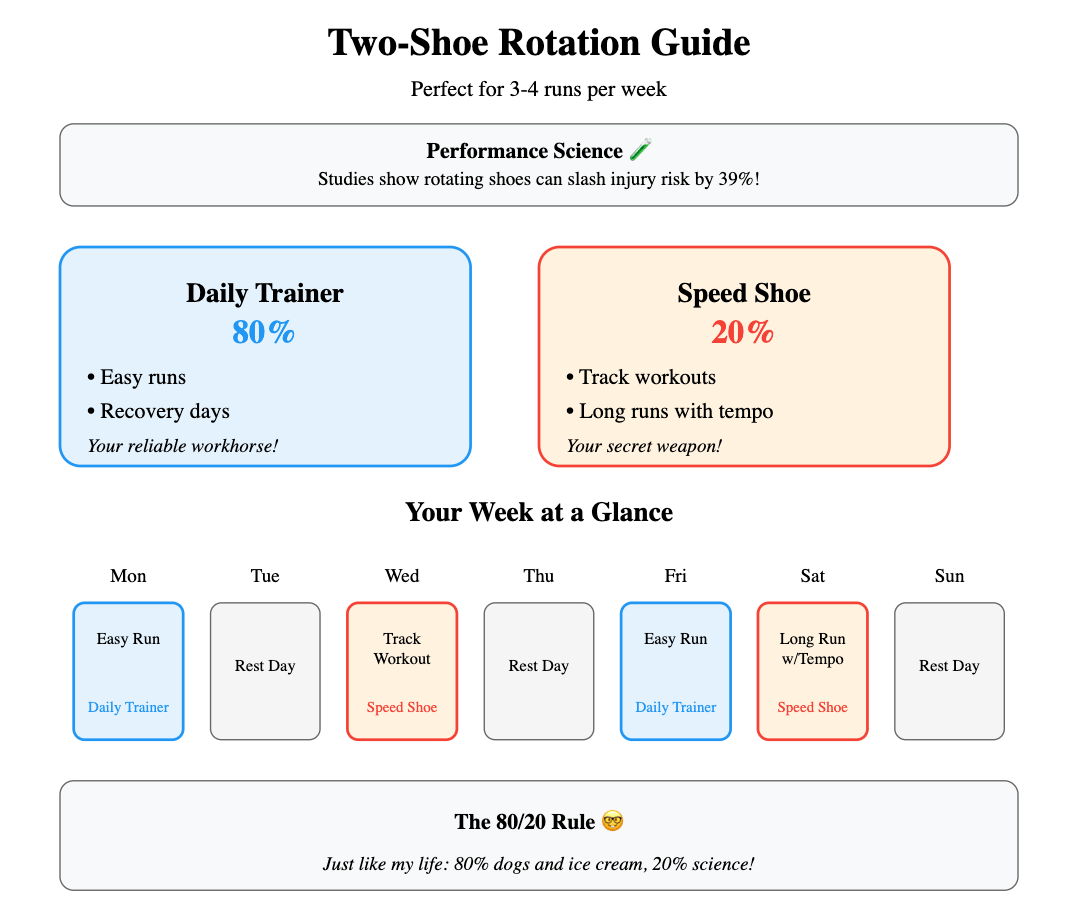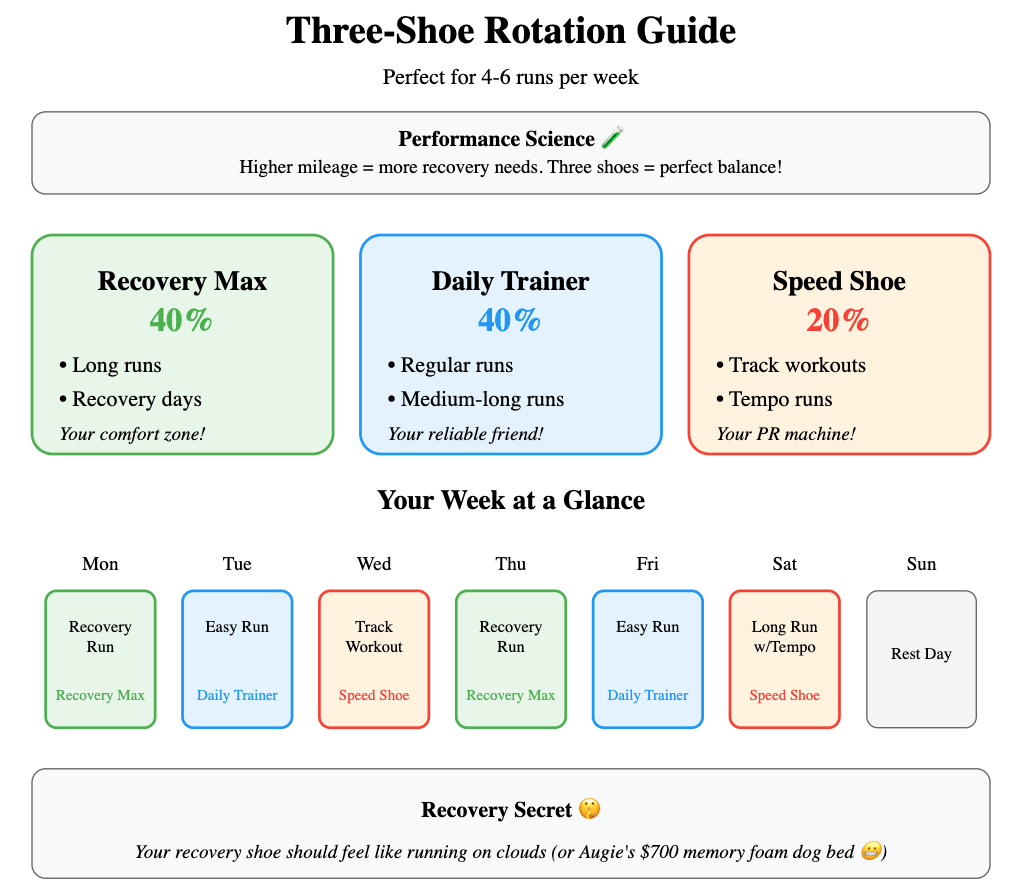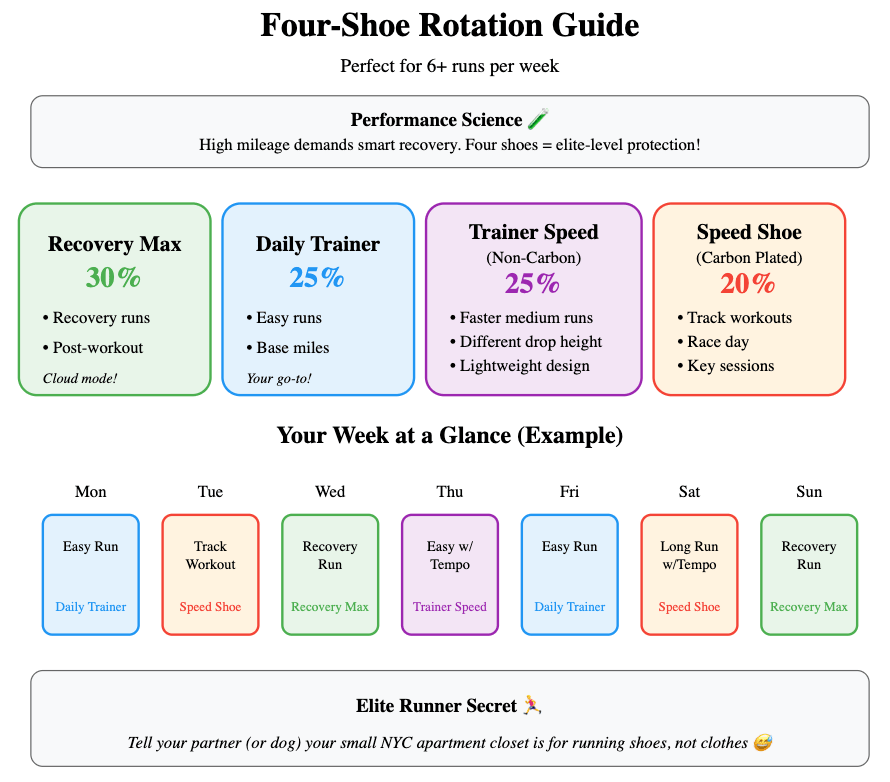The Ultimate Shoe Rotation Guide: Stop Letting Your Shoes Sabotage Your Marathon Training
Estimated read time: 3.37 minutes (about as long as it takes me to crush a pint of Ben & Jerry’s Half-Baked).
Hey Performance Nerds! Jonah here. 🤓
Want to cut your injury risk by 39%? You could be making one massive mistake: wearing the same shoes for every single run! 🚨👟
Today, we’re breaking down the science of shoe rotation:
Why sticking to one pair could be wrecking your recovery (and upping your injury risk) 💥
How rotating your shoes strengthens your legs and keeps you balanced 🏃♂️💪
My foolproof formula for building the perfect shoe rotation 🤓🧪

🚨 Don’t Miss Out—$4,575 Giveaway! 🚨
Our Marathon Science Giveaway is running through New Year’s Eve, and there’s only 1 week left to enter. Don’t miss out! 👇
🎁 The Ultimate Runner’s Dream Giveaway 🎁
Here’s what you could win:
🥇 Grand Prize ($3,500):
12 weeks of private, science-backed coaching with me—to help you train smarter and race faster!
The smartwatch I trust for tracking every metric and optimizing your performance.
🏃♂️ Stryd Pod + Pro Membership + Setup Call ($300): Revolutionize how you measure and improve every run!
How to Enter:
1️⃣ Share your referral link with friends 👇
2️⃣ Every friend you refer = another entry!
🎯 Bonus: Refer 5+ friends and unlock my FREE advanced 20-week marathon plan!
🚨 Act Fast: Giveaway closes at midnight, New Year’s Eve—don’t wait!
💡 Pro Tip: Share your referral link on Instagram (tag @rosnerperformance) or in your running group chats. Use the “Link” sticker for easy clicks!
Alright, enough of the non-sciencey stuff. Ready to dive into the secrets of running shoe rotation? Let’s go!

The Science of Shoe Rotation: Why Your Feet Need Options 🧪
Could the secret to running stronger, faster, and injury-free really be as simple as switching up your shoe swag? 🤔👟
Spoiler alert: Science says maybe.
Let's break down the science of why you need to be rotating running shoes.
The Single-Shoe Problem 🚫
Every footstrike creates forces up to 2.5x your body weight. That's a lot of stress! Your legs absorb these forces differently based on your shoes.
Using one pair of shoes means the same muscles and tissues take the same beating every run. It's like doing bicep curls every day of the year.
(Okay, fine, I do that - but at least I switch arms sometimes! 💪)
The Rotation Solution 🔄
Swapping between shoes distributes impact forces more evenly:
Low-heel drop shoes load your calves.
High-heel drop shoes shift stress to your upper leg
Each shoe changes how your foot strikes the ground
This variety is like cross-training for your legs. Instead of wearing out the same tissues, you spread the workload and give muscles time to recover.
The Results You'll See:
You engage different muscle groups with each run
Tissues have more time to recover, potentially reducing overuse injuries
You build balanced strength across all your muscles
Ready to build your perfect shoe rotation? Let's dive in! 🏃♂️
Building Your Perfect Shoe Rotation 👟
Your shoe rotation is the secret weapon most runners miss.
Your credit card company just called. They thought someone stole your card because you're about to spend too much money on shoes. 😅
Don't worry, tell them it’s for science. 🧪
Here's exactly what you need based on your training volume:
Two-Shoe Rotation (3-4 runs/week)

Here’s my fave daily trainers and speed shoe options for a two-shoe rotation.
Daily Trainers
Model | Description |
|---|---|
Nike Invincible 3 | Max cushioned with soft, bouncy ZoomX foam, perfect for recovery runs or piling on mileage. |
Adidas Ultraboost Light | Plush and supportive with responsive cushioning, great for smooth daily training. |
ASICS Novablast 5 | Lightweight and energetic with a trampoline-like ride, ideal for easy runs or tempos. |
HOKA Mach X | Combines HOKA's signature cushioning with added responsiveness, versatile for varied runs. |
New Balance Fresh Foam X 1080v14 | Comfortable and balanced with plush cushioning, great for long-distance training. |
Brooks Glycerin Max | Luxuriously soft and supportive, ideal for easy or recovery days when comfort is key. |
Puma Deviate NITRO™ 3 | Lightweight and responsive with Nitro foam, suitable for daily runs or speed training. |
Saucony Triumph 21 | High-cushion and durable with a smooth, supportive ride, perfect for steady daily mileage. |
Marathon Racing Shoes
Model | Description |
|---|---|
Nike Alphafly Next% 3 | Maximum energy return with a propulsive carbon plate, designed for elite-level marathon speed. |
Adidas Adizero Adios Pro 4 | Lightweight, high-energy foam and rods underfoot for powerful propulsion on race day. |
ASICS Metaspeed Sky Paris | Engineered for stride efficiency with a carbon plate, perfect for chasing marathon PRs. |
HOKA Cielo X1 | Lightweight, carbon-plated shoe with an efficient, smooth transition for long races. |
New Balance FuelCell SuperComp Elite v4 | Responsive cushioning and propulsive feel for runners aiming to maximize marathon performance. |
Brooks Hyperion Elite 4 | Low-profile, lightweight design with a carbon plate for speed and stability on race day. |
Puma Fast-R Nitro Elite 2 | Combines Nitro Elite foam with a split-plate design for a fast, cushioned marathon ride. |
Saucony Endorphin Elite | Ultra-responsive and aggressive, built for runners seeking top-end speed and efficiency. |
Three-Shoe Rotation (4-5 runs/week)

Daily Trainers
Model | Description |
|---|---|
Nike Pegasus 41 | Reliable and durable with balanced cushioning, ideal for everyday training. |
ASICS Novablast 5 | Lightweight and bouncy, great for daily miles and occasional tempo work. |
Saucony Ride 17 | Smooth and versatile with moderate cushioning for daily runs or mid-distance efforts. |
Brooks Ghost 16 | Neutral and comfortable, perfect for steady runs or beginners building mileage. |
New Balance Fresh Foam X 1080v14 | Cushioned and smooth, excellent for longer training sessions or easy runs. |
HOKA Mach X | Responsive yet cushioned, ideal for runners who mix easy miles with speedier efforts. |
On Cloudmonster Hyper | Max cushioning with Helion™ foam for soft landings and a smooth, bouncy ride, perfect for recovery runs or easy long miles. |
Recovery/Max Cushion
Model | Description |
|---|---|
Nike Invincible 3 | Plush and ultra-bouncy, designed for recovery runs and high-mileage comfort. |
Saucony Triumph 22 | Durable and cushioned for recovery runs or consistent daily mileage. |
Brooks Glycerin Max | Ultra-soft and supportive, great for recovery or runners prioritizing comfort. |
HOKA Clifton 10 | Balanced and lightweight, providing a smooth ride for easy days or recovery runs. |
New Balance Fresh Foam More v5 | Max-cushioning with a soft feel, perfect for long recovery sessions. |
On Cloudmonster | Oversized cushioning with a springy ride, great for easy and steady runs. |
Marathon Racing Shoes
Model | Description |
|---|---|
Nike Alphafly Next% 3 | High-performance racing shoe with max energy return and speed for marathon PRs. |
Adidas Adizero Adios Pro 4 | Lightweight and powerful with a carbon plate for long-distance races. |
ASICS Metaspeed Sky Paris | Optimized for efficient strides and fast marathon times. |
HOKA Cielo X1 | Lightweight and fast with smooth transitions for long races. |
New Balance FuelCell SuperComp Elite v4 | Responsive and propulsive for runners targeting competitive marathon finishes. |
Brooks Hyperion Elite 4 | Light and stable with a carbon plate for speed-focused runners. |
Puma Fast-R Nitro Elite 2 | Cushioned yet aggressive, designed for top performance in marathon racing. |
Saucony Endorphin Elite | Ultra-light and highly responsive for elite-level marathon racing. |
Four-Shoe Rotation (6+ runs/week)

Daily trainers, recovery, and race day are the same as a 3-shoe rotation. See below for selected speed/tempo shoes for a 4-shoe rotation.
Speed/Tempo
Model | Description |
|---|---|
Nike Zoom Fly 6 | Lightweight and propulsive for tempo runs and intervals. |
Saucony Endorphin Speed 3 | Nylon-plated and responsive, perfect for fast-paced workouts or tempo efforts. |
ASICS Magic Speed 4 | Versatile and snappy with a nylon plate, great for speed-focused training. |
HOKA Mach X | Responsive foam for quick transitions during speed sessions or tempo runs. |
New Balance FuelCell Rebel v3 | Soft and lightweight with a fast feel for shorter speed runs or tempo workouts. |
Puma Velocity NITRO 3 | Lightweight and durable with Nitro cushioning, ideal for tempos and daily speed work. |

Practical Summary
The Science:
Rotating shoes might reduce injury risk by 39%, backed by biomechanical research
Different shoe designs shift stress across muscles, helping overuse injuries
The Benefits:
Reduced strain on specific muscles, promoting faster recovery
Balanced strength across calves, quads, and other muscle groups
The Protocol:
Rotate at least 2-3 pairs of running shoes with different designs.
Include low-heel drop shoes for calf engagement.
Add high-heel drop shoes to target upper leg muscles.
Adjust rotation based on your weekly training volume and running goals
Replace shoes after 300-500 miles for optimal performance

#1 Carb Load Hack For Fast Marathons. 🏃🏻♂️💨
Did you miss my video about my #1 carb load hack to run your fastest marathon? You can find it below!
I won’t lie. These videos take me a while to make. If you find it helpful, share it on your story or with a friend. It helps me a ton

Are You a True Running Nerd? Prove it.. 🧐
Welcome to the prove you’re a nerd section. Each week, I ask a question about a common running science myth.
Submit Your Question!
Got a question for the Prove You’re a Nerd section? Think you can stump this brainy bunch?
Reply to this email 📨 with your best. I’ll pick a favorite to feature next week—with a shoutout! 🧠🏃♂️
What is the main purpose of electrolytes during a marathon?
Last Week’s Results
Well, performance nerds, you’ve shown once again that you're not only geniuses but also well-hydrated🫡.
Correct! The primary reason endurance athletes benefit from staying hydrated during long runs is that it helps maintain blood plasma volume. Proper hydration ensures your body can keep blood pumping efficiently! 💧💪
Here’s how the votes landed:
🟩🟩🟩🟩🟩🟩 1️⃣ Maintains blood plasma volume 💧 (161)
🟨🟨⬜️⬜️⬜️⬜️ 2️⃣ Prevents muscle cramps ⚡ (64)
⬜️⬜️⬜️⬜️⬜️⬜️ 3️⃣ Reduces muscle soreness 🏋️ (5)
⬜️⬜️⬜️⬜️⬜️⬜️ 4️⃣ Helps burn more fat 🔥 (2)

Nerdy Finds of the Week 📚🧑🔬
This section includes my favorite research, podcasts or books about running/lifting science.
Research Paper: Enthalpy efficiency of the soleus muscle contributes to improvements in running economy
Training Design: Isometric ankle training (5 sets of 4 reps, 3s loading/3s rest at 90% max effort), performed 3-4 times weekly
Key Adaptations: Training improved both muscle strength (+10%) and tendon stiffness (+31%), leading to a 4% improvement in running economy
How It Works: The combined muscle-tendon adaptations optimized the soleus muscle's shortening velocity during early stance phase, allowing it to operate at a more efficient speed while running.
Practical Translation: The 4% improvement in running economy from this training is significant. This was achieved without changing running technique or other training aspects, suggesting it could be a valuable addition to any runner's program.

Don’t forget: You + Science = AWESOMENESS 😎
Yours in science,
Jonah


Enjoy the newsletter? Please forward to a pal. It only takes 18 seconds. Making this one took 12 hours.
Please email me directly if you’re interested in references for this week!

